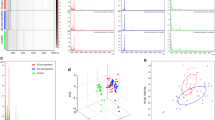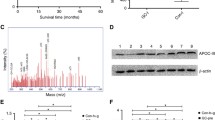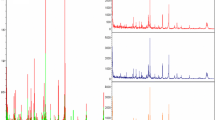Abstract
Gastric cancer (GC) is a very common disease worldwide where new serum biomarkers are urgently needed to improve their early diagnosis. In this study, we aim to search for the potential serum protein/peptide biomarkers of GC by using surface-enhanced laser desorption/ionization time-of-flight mass spectrometry (SELDI-TOF-MS). We first obtained the serum protein/peptide profiles from a training dataset including 30 patients with GC, 16 cases with chronic benign gastric disease (CGD), and 30 normal controls (CON) where 15 protein peaks were identified to exhibit the obvious deviation (P < 0.001, Wilcoxon rank sum test) among GC, CGD, and CON analyzed by Biomarker Wizard 3.1 software with three protein peaks with mass-to-charge (m/z) ratio 5910, 5342, and 6439 further confirmed in the validation dataset. Among the three protein peaks, peak 5910 displayed the most significantly different which could distinguish GC patients from CGD and CON with a sensitivity of 86.3 %, a specificity of 91.3 %, and the area under the receiver operating characteristic curve (AUC) of 0.89 by using the optimal cutoff value of 17.3. We further identified peak 5910 as the carboxyl terminal fraction of Fibrinogen α by LC-MS and validated its identity by antiserum-mediated SELDI-based immunodepletion assays. In sum, SELDI-TOF-MS method could effectively generate serum peptidome in cancer patients and provide a new approach to identify potentially diagnostic and prognostic biomarkers for cancer. The carboxyl terminal fraction of Fibrinogen α may be a potential serological biomarker for GC diagnosis.




Similar content being viewed by others
References
Kamangar F, Dores GM, Anderson WF. Patterns of cancer incidence, mortality, and prevalence across five continents: defining priorities to reduce cancer disparities in different geographic regions of the world. J Clin Oncol Off J Am Soc Clin Oncol. 2006;24:2137–50.
Yamaoka Y, Kato M, Asaka M. Geographic differences in gastric cancer incidence can be explained by differences between helicobacter pylori strains. Intern Med. 2008;47:1077–83.
Shah MA. Update on metastatic gastric and esophageal cancers. J Clin Oncol Off J Am Soc Clin Oncol. 2015;33:1760–9.
Pasechnikov V, Chukov S, Fedorov E, Kikuste I, Leja M. Gastric cancer: prevention, screening and early diagnosis. World J Gastroenterol. 2014;20:13842–62.
Leja M, You W, Camargo MC, Saito H. Implementation of gastric cancer screening—the global experience. Best Pract Res Clin Gastroenterol. 2014;28:1093–106.
Rocken C, Ebert MP, Roessner A. Proteomics in pathology, research and practice. Pathol Res Pract. 2004;200:69–82.
Hudler P, Repse S, Juvan R, Komel R. A genomic approach to investigate expression profiles in Slovenian patients with gastric cancer. Oncol Lett. 2011;2:1003–14.
Ekstrom S, Onnerfjord P, Nilsson J, Bengtsson M, Laurell T, Marko-Varga G. Integrated microanalytical technology enabling rapid and automated protein identification. Anal Chem. 2000;72:286–93.
Engwegen JY, Gast MC, Schellens JH, Beijnen JH. Clinical proteomics: searching for better tumour markers with SELDI-TOF mass spectrometry. Trends Pharmacol Sci. 2006;27:251–9.
Bouamrani A, Ternier J, Ratel D, Benabid AL, Issartel JP, Brambilla E, et al. Direct-tissue SELDI-TOF mass spectrometry analysis: a new application for clinical proteomics. Clin Chem. 2006;52:2103–6.
Rodrigo MA, Zitka O, Krizkova S, Moulick A, Adam V, Kizek R. MALDI-TOF MS as evolving cancer diagnostic tool: a review. J Pharm Biomed Anal. 2014;95:245–55.
Wu C, Liu L, Zhao P, Tang D, Yao D, Zhu L, et al. Potential serum markers for monitoring the progression of hepatitis b virus-associated chronic hepatic lesions to liver cirrhosis. Gut Liver. 2015;9(5):665–71.
Liu L, Yan B, Huang J, Gu Q, Wang L, Fang M, et al. The identification and characterization of novel n-glycan-based biomarkers in gastric cancer. PloS one. 2013;8:e77821.
Faul F, Erdfelder E, Lang AG, Buchner A. G*power 3: a flexible statistical power analysis program for the social, behavioral, and biomedical sciences. Behav Res Methods. 2007;39:175–91.
Rosty C, Christa L, Kuzdzal S, Baldwin WM, Zahurak ML, Carnot F, et al. Identification of hepatocarcinoma-intestine-pancreas/pancreatitis-associated protein I as a biomarker for pancreatic ductal adenocarcinoma by protein biochip technology. Cancer Res. 2002;62:1868–75.
Vlahou A, Schellhammer PF, Mendrinos S, Patel K, Kondylis FI, Gong L, et al. Development of a novel proteomic approach for the detection of transitional cell carcinoma of the bladder in urine. Am J Pathol. 2001;158:1491–502.
Adam BL, Qu Y, Davis JW, Ward MD, Clements MA, Cazares LH, et al. Serum protein fingerprinting coupled with a pattern-matching algorithm distinguishes prostate cancer from benign prostate hyperplasia and healthy men. Cancer Res. 2002;62:3609–14.
Gouin-Thibault I, Achkar A, Samama MM. The thrombophilic state in cancer patients. Acta Haematol. 2001;106:33–42.
Ebert MP, Lamer S, Meuer J, Malfertheiner P, Reymond M, Buschmann T, et al. Identification of the thrombin light chain a as the single best mass for differentiation of gastric cancer patients from individuals with dyspepsia by proteome analysis. J Proteome Res. 2005;4:586–90.
Yamashita H, Kitayama J, Kanno N, Yatomi Y, Nagawa H. Hyperfibrinogenemia is associated with lymphatic as well as hematogenous metastasis and worse clinical outcome in T2 gastric cancer. BMC Cancer. 2006;6:147.
Liu C, Pan C, Liang Y. Screening and identification of serum proteomic biomarkers for gastric adenocarcinoma. Exp Ther Med. 2012;3:1005–9.
Ebert MP, Niemeyer D, Deininger SO, Wex T, Knippig C, Hoffmann J, et al. Identification and confirmation of increased fibrinopeptide a serum protein levels in gastric cancer sera by magnet bead assisted MALDI-TOF mass spectrometry. J Proteome Res. 2006;5:2152–8.
Su Y, Shen J, Qian H, Ma H, Ji J, Ma L, et al. Diagnosis of gastric cancer using decision tree classification of mass spectral data. Cancer Sci. 2007;98:37–43.
Zhao C, Su Y, Zhang J, Feng Q, Qu L, Wang L, et al. Fibrinogen-derived fibrinostatin inhibits tumor growth through anti-angiogenesis. Cancer science 2015
Acknowledgments
This work was supported by the grant from the National Natural Science Foundation of China (No. 81101644).
Author information
Authors and Affiliations
Corresponding authors
Ethics declarations
Conflicts of interest
None
Additional information
Cheng Wu and Zhiwen Luo contributed equally to this work.
Rights and permissions
About this article
Cite this article
Wu, C., Luo, Z., Tang, D. et al. Identification of carboxyl terminal peptide of Fibrinogen as a potential serum biomarker for gastric cancer. Tumor Biol. 37, 6963–6970 (2016). https://doi.org/10.1007/s13277-015-4394-y
Received:
Accepted:
Published:
Issue Date:
DOI: https://doi.org/10.1007/s13277-015-4394-y




